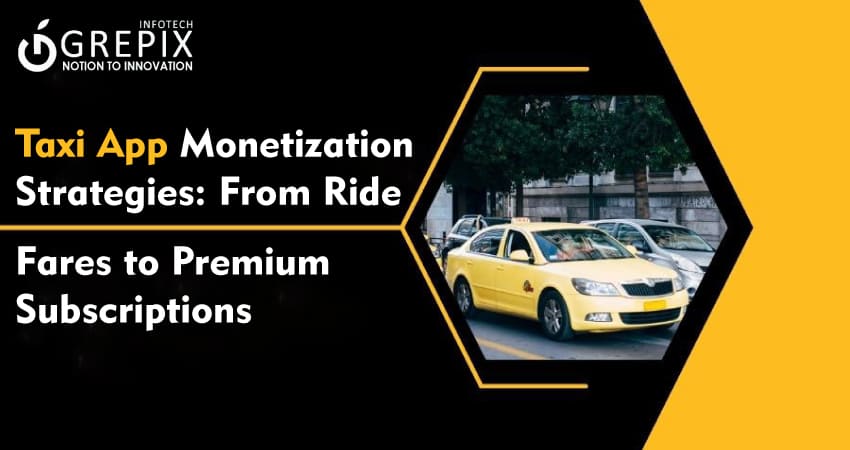Taxi App Monetization Strategies: From Ride Fares to Premium Subscriptions
Monetizing a taxi app is critical to its long-term success and profitability. While ride fares are a foundational revenue source, many other strategies can diversify income streams and make the business sustainable and competitive in a market with established players like Uber and Lyft. This guide explores various taxi app monetization strategies, from ride fares and premium subscriptions to partnerships and in-app advertising. By strategically combining multiple revenue sources, you can boost profitability, expand market reach, and create added value for drivers and passengers.
To ensure long-term success, a taxi app must implement diverse monetization strategies beyond basic ride fares. This comprehensive approach explores how ride fares, premium subscriptions, driver commissions, in-app ads, and partnerships with local businesses can boost profitability and increase app engagement. Leveraging these methods strategically, you can attract loyal customers, encourage driver retention, and build a competitive edge in the market. With Grepix Infotech, a leader in taxi app development, you gain the expertise to create a sustainable and profitable app tailored to evolving market needs.
Taxi App Monetization Strategies
1 Ride Fares: The Core Revenue Model
Ride fares are the most fundamental way for taxi apps to generate revenue. The ride fare is the basic charge passengers pay for the service, which usually includes a base fare plus a charge per kilometer or minute.
Types of Fare Structures:
- Base Fare: A flat rate charged at the beginning of each ride, regardless of distance or time.
- Per Kilometer/Mile Charge: Additional fees based on the distance traveled, ideal for long trips.
- Per Minute Charge: Charges based on the ride’s duration, are helpful in areas with heavy traffic.
- Minimum Fare: A minimum threshold that ensures drivers earn enough on short-distance trips.
2 Dynamic Pricing (Surge Pricing)
Surge pricing or dynamic pricing adjusts fares based on demand. For example, during peak hours, rainy days, or special events, ride prices increase to incentivize more drivers to hit the road and manage demand. This feature helps balance supply and demand while boosting profitability during high-demand periods.
Benefits of Dynamic Pricing:
- Maximizes profit during high-demand periods.
- Encourages more drivers to accept rides, reducing wait times.
- Adds a sense of exclusivity to the service during peak hours.
Challenges of Dynamic Pricing:
- High surge prices can lead to customer dissatisfaction if they feel overcharged.
- Proper implementation requires sophisticated algorithms to predict demand accurately and adjust prices fairly.
3 Premium Subscriptions: Enhancing the Rider Experience
Premium subscriptions offer users exclusive benefits for a recurring monthly or annual fee, appealing to frequent users who value convenience, comfort, or luxury.
Types of Premium Subscription Models:
- Ride Pass: For a monthly fee, users get discounted rates or flat-rate fares on all rides, saving money on frequent trips.
- Priority Booking: Subscribers receive prioritized access to drivers, reducing wait times, especially during high-demand periods.
- Luxury and Comfort Tiers: Customers can choose from a variety of high-end car options, including SUVs, elegant sedans, and even electric cars with additional features.
Benefits of Premium Subscriptions:
- Generates consistent revenue regardless of demand.
- Increases customer retention, as users feel they’re getting added value.
- Differentiates the app by offering exclusive, tailored services.
Challenges with Premium Subscriptions:
- Requires a strong value proposition to attract subscribers.
- Success depends on ensuring adequate availability of premium vehicles and drivers.
4 Driver Commissions: Profiting Through Service Facilitation
Driver commissions are a revenue-sharing model where the app takes a percentage cut from each ride fare. Typically, commission rates vary between 15% and 30%, depending on the app’s policies and the local market..
Factors Influencing Commission Rates:
- Location and Market Competition: In markets with intense competition, lower commission rates can attract more drivers.
- Service Tiers: Premium service tiers can command higher commissions due to increased operational costs.
- Driver Incentive Programs: Reducing commission rates for top-rated drivers encourages better service quality and driver retention.
Benefits of Driver Commissions:
- Provides consistent revenue from every ride.
- Encourages high-quality service by rewarding high-performing drivers.
- Offers flexibility to scale commission rates based on demand, competition, and other factors.
Challenges of Driver Commissions:
- High commission rates may deter drivers from joining the platform.
- Lower commission rates may require the app to rely on other revenue streams.
5 In-App Advertising: Leveraging High User Engagement
In-app advertising is an increasingly popular monetization strategy. By partnering with local businesses, brands, or service providers, taxi apps can offer targeted ads to users, creating an additional income stream without directly impacting the user experience.
Advertising Models for Taxi Apps:
- Banner Ads and Pop-Ups: Display ads on the app’s home or booking screens, targeting relevant audiences.
- Sponsored Content: Integrate relevant content, such as offers or suggestions for nearby restaurants, cafes, or events, within the app.
- Interactive Ads: Offer discounts or free ride credits to users who interact with certain ads, boosting engagement while driving ad revenue.
Benefits of In-App Advertising:
- Creates passive income that doesn’t depend on ride volume.
- Allows for precise targeting based on user location and preferences.
- Enhances the user experience when partnered with relevant brands (e.g., discounts at nearby restaurants).
Challenges of In-App Advertising:
- Ads should be non-intrusive to avoid compromising user experience.
- Requires active partnerships with local businesses and brands, demanding ongoing maintenance and negotiation.
Also Read: "Innovative Clone App Ideas to Kickstart Your Entrepreneurial Journey "
6 Corporate Partnerships and Employee Transportation Services
Corporate partnerships offer a way for taxi apps to secure long-term, high-value contracts with companies needing reliable transportation for their employees. This model is particularly popular with companies in metropolitan areas where parking is expensive or limited.
Options for Corporate Partnerships:
- Employee Commute Services: Provide daily transportation for employees at discounted rates.
- Corporate Discounts and Subscriptions: Offer companies special discounts or subscriptions, saving them money on bulk rides.
- Event Transportation Services: Provide transportation solutions for company events, conferences, and meetings.
Benefits of Corporate Partnerships:
- Provides predictable, recurring revenue from corporate clients.
- Increases brand visibility as companies recommend the app to employees.
- Strengthens relationships with local businesses, creating further partnership opportunities.
Challenges of Corporate Partnerships:
- Managing contracts and pricing can be complex, requiring negotiation and customization.
- High demand during peak hours may strain resources, impacting customer satisfaction.
7 Loyalty Programs and Referral Incentives: Driving Organic Growth
Loyalty programs and referral incentives attract new users and reward existing customers, increasing user retention and engagement. By offering points or ride credits that can be redeemed for discounts, users are motivated to continue using the app and to share it with friends.
Examples of Loyalty and Referral Models:
- Point-Based Loyalty Programs: Award points for each ride, which can be redeemed for discounts or free rides.
- Ride Rewards: Offer cashback or credits after a set number of rides, incentivizing frequent use.
- Referral Bonuses: Reward users who refer friends with ride credits or discounts, encouraging organic growth.
Benefits of Loyalty and Referral Programs:
- Enhances customer satisfaction by providing tangible rewards.
- Encourages users to choose the app over competitors, especially if they are close to earning a reward.
- Drives user acquisition through referrals without requiring high marketing spend.
Challenges of Loyalty and Referral Programs:
- Requires careful monitoring to prevent reward abuse.
- Initial costs can be high if large numbers of users redeem rewards frequently.
8 Fleet Management and Leasing Programs for Drivers
Some taxi apps, especially in emerging markets, can introduce a vehicle leasing or fleet management program to generate revenue. This allows the app to offer rental cars to drivers who lack access to a vehicle, creating an additional revenue stream while expanding the driver base.
Types of Leasing Programs:
- Short-Term Rentals: Drivers can rent vehicles on an hourly, daily, or weekly basis, which is useful for part-time drivers.
- Long-Term Leasing: Offers drivers vehicle ownership options over time, building loyalty and reducing driver turnover.
- Electric Vehicle (EV) Programs: With the rise of sustainable transport, leasing EVs offers drivers cost savings and attracts environmentally conscious riders.
Benefits of Fleet Management Programs:
- Creates additional revenue through leasing fees and maintenance charges.
- Expands the pool of drivers, ensuring adequate supply even during high-demand periods.
- Enhances brand image as an inclusive, driver-supportive platform.
Challenges of Fleet Management Programs:
- Requires a significant upfront investment in purchasing and maintaining vehicles.
- Managing leases, maintenance, and insurance can be complex and resource-intensive.
9 Ride Packages and Bulk Ride Sales
For businesses or regular users, offering ride packages or bulk ride sales can be especially alluring as it enables them to buy rides in bulk at a discounted price. This business model promotes client loyalty and guarantees revenue.
Examples of Ride Packages:
- Multi-Ride Packages: A set number of rides purchased upfront at a discounted rate, ideal for frequent users.
- Corporate Ride Packs: Bulk ride sales designed for corporate clients, providing savings for companies that purchase rides in large volumes.
- Subscription-Based Packages: Monthly subscriptions with a set number of rides or discounts, targeting daily commuters.
Benefits of Ride Packages:
- Ensures predictable revenue and promotes regular use.
- Attracts customers seeking cost-effective transportation options.
- Simplifies the ride booking process for regular users, enhancing convenience.
Challenges of Ride Packages:
- Requires careful pricing to maintain profitability.
- May reduce per-ride earnings if package discounts are too deep.
10 Partnerships with Other Services: Adding Value to the Ecosystem
Taxi apps can partner with providers to offer bundled services or complementary benefits. For instance, partnering with local restaurants for meal delivery or hotels for guest transport creates additional revenue streams and adds value to the app.
Popular Partnership Options:
- Food Delivery: Integrate with food delivery services, enabling drivers to earn extra by delivering meals during off-peak hours.
- Hotel and Airline Partnerships: Provide hotel or airport transportation, offering packages for travelers.
- Health Services: Partner with health services or hospitals for patient transport, useful in urban areas.
Benefits of Service Partnerships:
- Diversifies revenue streams and fills gaps during off-peak hours keeps drivers busy and provides additional revenue.
- Partnerships broaden the app's reach and create more reasons for users to engage with the app, driving brand loyalty.
- Supporting local businesses through delivery partnerships strengthens community ties, enhancing the app’s reputation in its operating regions.
Challenges of Partnerships:
- Balancing the demand for diverse services can strain driver availability, impacting core ride-hailing reliability.
- Ensuring consistent service quality across multiple offerings adds operational complexity.
- Integrating additional services requires driver training and resources, raising logistical challenges.
Conclusion
Monetizing a taxi app involves a multifaceted approach that maximizes revenue potential through various complementary strategies. While ride fares remain the primary revenue source, integrating premium subscriptions, driver commissions, in-app advertising, corporate partnerships, and loyalty programs creates a sustainable business model that appeals to users and drivers.
Grepix Infotech is a trusted taxi app development company that offers the expertise and support needed to implement these diverse monetization strategies effectively. By working with us, you can confidently develop a competitive taxi app that leverages each monetization method to drive growth, strengthen brand loyalty, and enhance customer satisfaction. Grepix’s comprehensive approach to development and monetization ensures your taxi app remains profitable, adaptable, and resilient in an ever-evolving market, setting you up for long-term success.
Looking out to start your own venture like Uber? Try out our HireMe Taxi Uber Clone, the easiest way to kick-start your taxi business.







